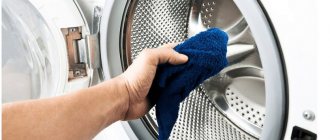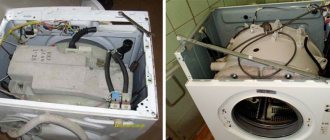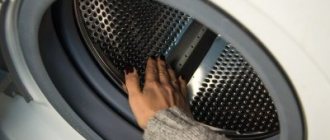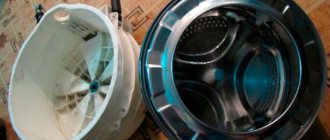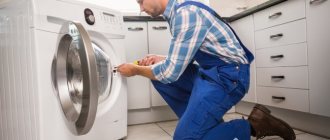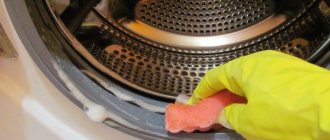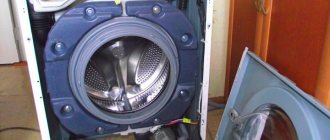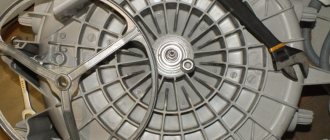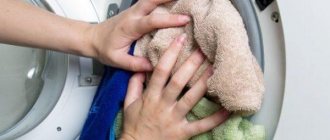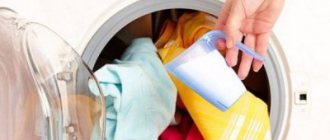During washing, many small items can get inside the appliance, under the drum?. This situation is dangerous because... a foreign body will not only affect the quality of washing, but can also cause a breakdown of the entire system. Therefore, for many equipment owners, the important question is what to do if an object gets under the drum of the washing machine, how to get it out and whether it is necessary to call a technician.
When to call a specialist?
Three situations are possible:
- A thin object, such as a bra wire, got stuck in one of the holes in the drum. To remove it, pinch the accessible end with pliers and gently pull, being careful not to break it. Of course, such a task can be completed without a specialist.
- The loss is not visible, but you are sure it is in the typewriter. Small things like a chain, screw, or coin may end up in the drain filter. It’s not difficult to get them yourself - you don’t need a master either.
- If you hear a clanging noise as the machine is running, as if metal is rubbing against metal, a foreign object may have gotten underneath the drum. At this point you need to call a specialist. A metallic sound may also indicate wear or malfunction of a part. It is difficult to diagnose a breakdown without the help of a specialist.
Can I change it at Sberbank?
If the store refuses to accept washed and restored money, you should contact any bank, for example Sberbank, to exchange it.
According to the Regulation adopted by the Bank of Russia on December 26, 2006 No. 1778-U, banknotes with minor damage are considered solvent and subject to exchange:
- having spots;
- those that have lost their original color (faded or stained fabrics during molting);
- worn, wrinkled, deformed;
- torn or lost edges and corners.
Such money is exchanged in all Russian banks without any payment and in the monetary equivalent corresponding to the previous denomination. Exchange operations are carried out not only by government institutions, but also by commercial institutions.
Banks even exchange torn banknotes that have retained at least 50% of the original size. In addition, banknotes glued together from several fragments are subject to exchange.
In this case, the following criteria for the validity of the banknote are taken into account:
- parts must belong to one banknote of the same denomination;
- each part of damaged money must be 50% of the initial area;
- bills glued together from several fragments must retain 50% of the area in at least one of the parts.
An important condition for exchanging money damaged by washing is to preserve the number, series and banknote certifying their nominal value.
Metal money that is deformed or has changed its original color after washing is also exchanged. The main thing is that information about belonging to Russian coins and nominal features are preserved. As for the remaining area, it should be at least 70% of the previous volume.
The algorithm for contacting a bank involves submitting an application to exchange damaged money and providing an identification document, that is, a passport.
After assessing the condition of the banknotes, the client will be exchanged in full for solvent banknotes. There are no restrictions on the amount required for exchange.
Nuances of exchanging damaged foreign currency
The bank will only replace banknotes that have not undergone significant damage that has changed their appearance.
Worn and faded dollars can be exchanged subject to a commission fee of 3–10% of their total value.
At the same time, the number, series and denomination of the banknote must be clearly visible on banknotes .
You will find maximum useful information about washing clothes and various fabric products here.
How do they get there?
There are three ways for foreign objects to get into the machine:
- Every little thing falls into the drum from clothes sent for washing. If you just get lazy or forget to check your pockets, a problem is just around the corner. It’s not so bad if the dropped item gets damaged, and it’s much worse if the equipment gets damaged. The most common “clients” of the drum are money, jewelry, and fasteners. It happens that more important things - a phone or a passport - are accidentally erased.
- During rotation, beads, buttons, and other accessories may come off from clothing. Also, during the washing process, solid elements of bras may fall out.
- "Force Majeure". If small children or pets have access to the machine, they can easily put some toy or any other thing inside. By the way, foreign bodies can enter not only through the hatch, but also through the powder cuvette.
Keys
Forgetfulness is an understandable human trait, but forgetting your keys in your pocket is definitely not a good idea. If we are talking about car keys, you should understand that water is dangerous, because the mechanism will inevitably suffer. In addition, like coins, keys can damage the inside of the car and ruin the drum. Repairing such a breakdown is very expensive! Always check pockets before putting items in the wash. Even if your keys are dirty, you definitely shouldn't clean them in the car.
Express extraction
As soon as you realize that something unnecessary has gotten into the machine, take action immediately. Cancel a running program. This is done like this:
- Press the “start/pause” button of the selected program - the machine will stop washing.
- Press the same button again and hold for five seconds.
- Wait until the pump pumps out water and the machine turns off.
There are machines that do not have automatic draining. In this case, you will have to drain the water through an emergency drain or through a drain filter. This must be done to unlock the hatch door. Afterwards, the door is opened and the foreign body trapped inside is removed.
How to call a specialist
To call a home appliance repair specialist:
- Call: in Moscow4
- in St. Petersburg
When contacting by phone please provide:
- Type of equipment, brand and, if possible, model;
- What exactly broke - describe in your own words;
- Indicate the date and time convenient for the repair;
- Contact information: phone number, address, full name, nearest metro station.
How to remove small items from the washing machine?
If you are sure that the source of the noise during rotation is something foreign, you can try to remove it yourself. Provided that you have basic skills in handling equipment and tools. The wall of front machines is removed; depending on the model, the front or rear wall is removed. Before disassembling the unit, familiarize yourself with the diagram of this process. For example, let's look at the most common option - you need to remove the thing by first removing the top cover and back wall:
- Drain the water and disconnect the machine from the power supply.
- Unscrew the bolts securing the top cover - they are located on the rear wall - and remove the cover.
- Unscrew the screws that secure the back wall and remove it. At this stage, you can detect soft objects - for example, paper, a belt or a sock. Once outside the drum, they are wound onto the heating element. But you shouldn’t stop there, because if you hear a noise, you need to look for a solid body that could have produced it. So let's move on.
- Take out the heating element (heating element). To do this, disconnect the wiring that goes to it and unscrew the fastening nut. The heating element can be removed by hooking it with a screwdriver.
- Illuminate the hole formed after removing the heating element with a flashlight. The debris that is there needs to be removed. Small things often get caught in the gap between the tank and the drum. To make sure there is nothing else, rotate the drum - if a foreign element is stuck, it will fall out during movement.
- Build a wire hook. The length and configuration are selected taking into account the location of the stuck item. Take out the loss by picking it up with a hook.
- If you have already removed the heating element, clean it of deposits. When returning it to its place, make sure it fits exactly there. Tighten the nut and connect the wires.
- Reassemble the machine parts in reverse order. Tighten all fasteners.
How can foreign objects damage your washing machine?
If any part gets into the space under the drum, it is usually accompanied by a grinding noise when it rotates. It should be borne in mind that the foreign object must be removed from the tank, otherwise it may cause damage to it and lead to a leak in the washing machine. Foreign objects can be classified into several types:
- hard (pins, paper clips, screws, buttons, keys, coins);
- soft (underwear, tights, socks).
Hard parts usually do not affect the operation of the device in any way, but they can cause an unpleasant grinding noise that the equipment will make during the washing process. However, sharp elements, such as screws, can pierce the cuff or tub, which in turn will lead to damage to the washing machine.
Soft items sometimes get stuck between the drum and tub. If a bra bone slips through the hole in the tank, it can damage the rubber cuff, causing the machine to start leaking. In addition, this part may cause the drum to jam, which will cause the wash to stop.
In order to find out exactly where the foreign part is located, you need to slowly turn the drum, illuminating this area with a flashlight. If a foreign object cannot be seen, its location can be identified by the noise it makes.
How to remove a foreign object from the drum of a washing machine yourself?
If you are sure that there really is a foreign part inside the machine, you can try to remove it yourself, especially if you have some experience in assembling and disassembling this equipment. First of all, you need to remove the front or back wall, it all depends on the specific model, which can have horizontal or vertical loading. In order to avoid mistakes, it is better to first read the instructions, which indicate a diagram for disassembling the washing machine drum.
Before you begin disassembling the equipment, you need to disconnect it from the power supply and drain all the water using a drain hose. Then unscrew the screws on the front or back wall and remove it. Remove the powder container and remove the control panel, first disconnecting the wires. Next, remove the rubber cuff, unscrew the bolts on the bottom panel and remove the front wall along with the hatch.
Now you need to remove the drum. It consists of two parts connected by bolts. Before removing the tank, you should disconnect the wires, pipes and other elements that are connected to it. In addition, the motor located on the back of the tank must be disconnected. Reassembling the drum is carried out in the reverse order.
Advice. If you are not sure that you can disassemble all the elements yourself, it is better to seek help from professionals who will perform this procedure without damaging the equipment.
Bra in the washing machine
What's the harm?
If a bra wire gets into the machine, and the user ignores this fact, the following problems may occur:
- Mechanical damage to device parts. At high rotation speeds, the solid element acquires enormous force - it can easily pierce the walls of the drum and disrupt the integrity of the tank or heating element. We will have to repair damaged elements and fight the flood.
- Damage to the rubber seal around the hatch.
- Rotation lock.
- Even if it doesn’t interfere, a bone stuck somewhere in the depths will begin to rust over time and begin to stain clothes that are washed in the machine.
You can tell if a bone is stuck by hearing extraneous sounds. You can remove it in the same way as any other items - by disassembling the device. We have provided instructions above.
How to get it?
The extraction process depends not only on the location of the item, but also on the material from which it is made. Bra inserts are made of plastic and metal. Iron ones are much more dangerous - they can seriously harm the machine. But they can be removed with a magnet without resorting to disassembling the device. To get the plastic analogue, disassembly is required.
Extraction through heating element
The method is suitable for models with a heating element located at the rear. Sequencing:
- Disconnect the device from the power supply - remove the plug from the socket.
- Turn the device over so that it is convenient to enter from behind.
- It’s good if there is a service hatch, you can work through it. If it is not there, remove the wall and remove the heating element, disconnecting the wires. Then they take out the “lost one”.
What if through the drain?
If the bra element is stuck in the pipe, it is removed from below. The order is:
- Disconnection from the power supply;
- Installing the device in a convenient position;
- Removing the container for washing powder;
- Turning the machine over onto the side wall;
- Unscrewing the screws and removing the clamps securing the bottom of the device - this way you can get to the drain pipe;
- Removing the pipe;
- Removing the bone. Cleaning and installing the pipe. Machine assembly.
No disassembly
If the bone is at the bottom of the tank, you can do without disassembling it. A flashlight and something thin, for example, a knitting needle or wire, will be available as auxiliary tools. After establishing the exact location of the loss, it is hooked with a hook made of wire/knitting needles. Moreover, there should be hooks at both ends. The object being removed is picked up first. The other one will come in handy in case of the fate that befell the bra wire. Having inserted the hook into the hole, pry the thing up and slowly scroll it until the bra insert stands vertically. As soon as the end of the bone gets into the hole, the pliers go into action.
A coin got inside the washing machine. How can I get it?
There are cases when some incomprehensible breakdowns occur with the washing machine.
At first glance, everything seems to be fine, but there are still some small faults. Firstly, if any object gets into the washing machine, for example a bra wire or a coin, you should under no circumstances delay removing it. If you don't remove the foreign object from the car, something worse can happen. A bra wire, a coin, a pin, rings - these are all small objects, but they carry great danger. In cases where a nail is stuck under the tank, it may soon even break through it under the influence of certain circumstances. Of course, everything can be fixed or replaced, but sealing a tank is not a cheap pleasure. If you cannot remove the foreign object from the washing machine yourself, it is better to invite a professional. Small stuck objects can also cause other harm, for example, using a coin or a bone from a bra can jam the drain pump (pump). There is nothing terrible or deadly about this, but you will still need the help of a master. Yes, it can be caused in any case, because such small and inconspicuous at first glance objects are actually very dangerous. It’s never clear what they might do or where they might get stuck. But you still have to call a specialist.
If you find a foreign object, it is better to call a specialist immediately, even though it is just a bra tassel or a coin that is stuck. There is also such a case, it is of course quite rare, a small object that got into the drain pump caused a power surge, and then the washing machine programmer failed. Of course, in this case the control module is broken and the machine cannot be used. And the very first thing you need is a lot of money to repair your washing machine, which is not very pleasant.
When you first detect a foreign object, you cannot ignore it; this is the first rule, the restraint of which can protect the washing machine from further and more serious damage. In such cases, if an iron or other metal object comes into contact with it, you cannot wash it; you must immediately interrupt the washing process. A master in this case will come in very handy. The usual maintenance of all operating rules will extend the life of the washing machine, and it will remain in good condition for a very long time and can serve as long as possible.
Source
How to avoid problems?
To prevent breakdowns and not resort to expensive repairs, it will be useful to listen to constructive recommendations:
- Make it a rule: before washing, you should turn out all the pockets of your clothes.
- Sew on poorly holding buttons and small accessories in a timely manner.
- Look inside the machine and into the powder drawer before loading clothes.
- Buy laundry bags. They come in a variety of shapes and sizes, and can be used to wash everything from socks to down jackets. There are even special containers for washing bras. You can also wash sneakers and textile shoes in bags. Thanks to such useful, unpretentious devices, you will maintain the attractiveness of things and protect your washing machine from troubles.
Video “How to remove a foreign object”:
Underwear
It’s clear that sending your underwear to the car with all your other things is simple and convenient. Unfortunately, this is dangerous for both your things and the machine. Hooks and fasteners can catch on other clothing, causing damage. In addition, they can get caught on parts of the washing machine, which will damage it from the inside. Wash these items by hand or buy a special underwear bag to wash in. This will be much safer, because this way you will not damage the drum, and your underwear will retain its attractive appearance longer thanks to gentle washing.
Lost weight: what Sofia Tarasova sacrificed for the sake of “VIA Gra” (new photos)
A Brazilian travels 36 km by bike every day to take his loved one home.
The money tree pleases with lush flowering: my secret is in caring for the leaves
How did the object get into the car?
First of all, we need to say why foreign objects appear in the washing machine. They end up in the car along with the clothes whose pockets you were too lazy to check. The most common item is money, or rather coins, although paper coins also sometimes end up in the drum. In addition, some managed to wash a credit card, passport, phone, gold chain and rings. Often, service center technicians take seeds, pins, bolts, nuts, and hairpins out of the car.
Running shoes
Regular running shoes are quite safe to machine wash, however, trying to wash your running shoes can be costly - they may shrink! If the shoes have a label indicating that they are safe to machine wash, simply remove the soles and place the sneakers in separate pillowcases. After this, wash them with towels, which will soften the impact.
Recommendations
Unpleasant situations with foreign objects in the washing machine can be prevented if you are a little more careful and follow the recommendations:
- firstly, you need to check the pockets of your clothes before washing and the reliability of how small details on the clothes are sewn;
- secondly, check the contents of the drum before washing and look into the powder cuvettes;
- thirdly, clothes with sewn details, zippers, buttons, underwires, etc. need to be washed in a special bag. And then nothing will get into the car tank and damage it.
Violation of such simple rules leads to unpleasant situations. In the best case, some unnecessary thing will be damaged, in the worst case, a foreign object will pierce the tank, and then expensive repairs cannot be avoided.
Interesting:
- Share your opinion - leave a comment
When a foreign object gets between the drum and the tub during washing, it can lead to serious damage to the machine. Most often, small items left in pockets end up there - coins, small keychains, pins, screws, as well as clothing items. Sometimes children also make their “contribution” by pushing small toys through the powder hatch. Whatever gets into the washing machine mechanism, you need to try to remove it quickly.
Where to get a foreign object from the washing machine
Now let’s talk in more detail about what and how to do if something gets stuck in the washing machine. You should definitely get it out, but first you need to decide on the “favorite habitats” of foreign objects in washing machines. So, foreign objects “like” to be located:
- in the cuff of the hatch, as a rule, clogging into its fold;
- in the drain pipe - this place is “favored” by coins, nails, screws;
- in the drain filter - this is the place for “storing” coins, nuts and screws, various small plastic things that have already slipped through the pipe, but have not yet managed to get into the pump;
- in the pump - small plastic objects and accessories, buttons, matches, etc. are collected here;
- in the drain hose there is a “warehouse” of matches, small pins, plastic dowels, which get there through the pump.
Do you always need to call a professional?
The easiest option is when you need to remove a bra bone stuck in the hole of the drum. In this case, you need to pinch the protruding end with pliers and carefully pull it out, without making sudden movements, so that the bone does not break off. Anyone can do such manipulations independently.
If the object is not visible, but you know for sure that it got into the machine and can cause the drum to break, check the drain filter - coins, small screws and other small foreign objects most often end up there. Sometimes a bra bone can be found in the filter of the machine. You can also perform this procedure yourself. In other cases, it is best to invite a specialist.
If you hear the sounds of metal rubbing against metal during washing or spinning and you just assume that a foreign object has gotten behind the drum, calling a specialist will be necessary. Such noises may be evidence of wear or breakage of parts, and it is difficult for a non-specialist to determine this on their own.
What to do if an object gets stuck in the washing machine tub?
The tank is the outer, sealed part of the drum, into which objects can also fall without the possibility of their easy removal.
If an object gets caught, without getting stuck and preventing the entire cycle from working, you just need to remove the protective, factory screen and take out the “lost”.
If the “loss” interferes with the operation of the drum, you must use the tips described above - disassemble the “working compartment”, followed by removal procedures - in no case should you continue the washing cycle any further - this can be dangerous for the household appliance.
Advice! Some small “losses” (phone cases, soft toys, socks, etc.) during washing can (sometimes with great surprise) be discovered in the tank - check it sometimes even for preventive purposes.
Instructions for removing a foreign object
If you are sure that the cause of uncharacteristic sounds when the washing machine is operating is a foreign object that has gotten into it, and working with equipment is not new, then you can remove it yourself. In machines with horizontal (front) loading, this requires removing the back or front wall. Most often the rear, but this nuance depends on the model. There are other differences in different models, so before continuing work it is better to find a disassembly diagram for a specific washing machine.
Here we will give instructions for disassembling the most common version with removing the back wall and top cover. Before proceeding with disassembly, drain all water from the machine through the drain hose and turn off the power supply.
Next you need to perform the following steps.
- Unscrew the two bolts on the back wall - they secure the top cover.
- Slide the cover back a little and it will come off.
- Unscrew the screws securing the back wall and remove it.
- Sometimes items of clothing (belts, socks, handkerchiefs, thin scarves) that fall behind the drum are wound onto the heating element (heating element), then they can be seen already at this stage. But even after removing them, if you hear noises when the washing machine is operating, it is better to check if anything else has gotten inside.
- Remove the heating element. To do this, you need to disconnect the wires going to it and unscrew the fastening nut. The heating element can be hooked onto the visible part with a screwdriver and pulled out.
- Shine a flashlight through the hole formed, and then you can see a bra bone or other object caught between the surface of the drum and the tank. If nothing is visible, spin the drum; perhaps something is stuck at the top: when scrolling, it will fall to the bottom of the tank.
- Make a hook out of wire (its length and configuration depends on the location of the stuck piece of clothing) and use it to remove the foreign object.
- Install the heating element, having first cleaned it of scale. In this case, you need to make sure that it fits tightly into place, then tighten the fastening nut and connect the wires.
- Assemble the machine by tightening the bolts on the back wall and replacing the top cover.
Before disconnecting the wires, you need to draw a diagram of their connection or take a photo, so that later you can make the connection correctly.
Effective methods for restoring the original appearance of washed banknotes
It is important to process washed money correctly. There are several ways to help restore the normal appearance of paper bills and coins. They involve drying and eliminating the smell of mold.
How to dry it properly?
The most common method is drying between clean sheets of paper. To this end, you should perform the following steps:
First, carefully lay the banknotes on a terry towel and cover the top with another towel or soft rag. This will remove most of the moisture.- After this procedure, each bill should be carefully spread out on a sheet of paper, covering the top with the same one.
- Place a book on top of the second sheet (to prevent deformation of the banknote).
- As the paper sheets become damp, they should be replaced with new ones until the money is completely dry.
The method is quite effective, but time-consuming. There are other equally effective measures to restore washed money.
Iron drying
It is recommended to dry money while smoothing it with an iron on an ironing board. The algorithm of actions is as follows:
- lay down a clean soft cloth, carefully placing wet bills on it;
- cover the top with the same fabric;
- Having set the iron to the minimum temperature setting for any type of fabric (cotton, wool, synthetics), you should carefully iron the fabric surface until it is completely dry and the paper money is restored.
Drying coins is much easier. They must be rinsed under running water and laid out in one layer on a soft cloth.
Drying with a hairdryer
You will have to hold the banknote with one hand and direct the warm jet of a hairdryer onto it with the other . Using hot air will dry the money paper quickly, but forced drying often results in warping.
Before such drying, preliminary preparation will also be required, including removing moisture with a towel. This procedure is described above.
On a rope
This method will also give positive results for drying banknotes. But it has disadvantages:
- the use of clothespins will cause the ends of the banknote to break;
- when suspended, banknotes curl and become deformed;
- In the end, you will still have to resort to using an iron.
Of the methods described above, ironing washed money is the fastest and most effective. After this procedure, they will acquire their original condition and payment status.
How to get rid of mold?
Removing mold from coins is not difficult. They can be washed in water with the addition of bleach or vinegar. Another method involves using any detergents and cleaning products used when treating a bathtub or sink. In both cases, after this procedure, it is recommended to rinse the coins under running water and dry them.
Mold that appears on banknotes after accidental washing in a machine is more difficult to remove.
To eliminate fungal infection, you can use the following proven methods:
- Wipe banknotes with a detergent containing chlorine. To do this, apply a small amount of liquid to a cotton pad and wipe the money with it. Then remove the product with a damp cloth.
- Vinegar diluted in water fights mold well. The ratio of components is 1 part vinegar to 5 parts water. The banknotes should be wiped with a cotton pad and dried with this mixture.
- A more aggressive, but most effective treatment of paper money against mold is immersion in cold water with the addition of liquid soap, shampoo or shower gel.
It is not recommended to soak paper money in any solution for more than 30 seconds, as it may get wet.
What to do if the bra bone is not visible through the hole from the heating element?
If an object is stuck between the tub and the washer drum near the shaft at the top of the tub, it may not be visible through the heating element hole. In this case, you need to perform a number of actions.
- Block the pulley with a wooden block. This is done so that the drum does not rotate during further actions.
- Unscrew the pulley mounting bolt.
- Remove the pulley and screw the bolt back (do not tighten it all the way).
- Perform several sharp blows with a hammer on the bolt. In order not to damage the thread, blows must be applied by first placing a wooden plank.
- After the impacts, the shaft with the drum should move forward, and the foreign object should fall down.
- Put the pulley in place, tightening the bolt tightly so that it cannot come loose during washing or spinning.
- Replace the back wall and cover and tighten all fasteners.
Excessive amount of things
It may seem like loading as much stuff into your car as possible is a way to simplify the process. However, if your machine is overcrowded, there is no room for the laundry to move and as a result, items end up unwashed. In addition, excessive load can negatively affect the mechanism. Drum overload is a leading cause of washing machine and dryer failure. Try not to make this mistake and don't overload the machine.
Found a violation? Report content
Prevention
To protect your equipment from damage and not disassemble it in order to remove a bra bone that has fallen into the tank, you need to follow several recommendations.
- Clothes with rhinestones, plastic or metal parts, including bras with underwires, should only be placed in the washing machine in a washing bag.
- Small things - belts, handkerchiefs, socks - should also be put in such a bag.
- Before storing things, carefully check your pockets.
- Monitor the condition of the rubber seal near the hatch.
- Before each wash, check that there are no foreign objects in the drum.
By following these tips, you can not only get the “extra element” yourself, but also avoid unnecessary hassle associated with disassembling the washing machine or even repairing it.
“>
Coins
It's happened to everyone - in line you get change in coins and don't want to hold up everyone else, so you just put the money in your pocket. Then you put your pants in the wash and notice that the sound is much louder than usual. It makes you remember the change you forgot. Small pieces of metal may seem harmless, but they can cause damage. For example, coins can damage the drain pipe if they pass through the filter. In addition, they can block the drain or even break the glass in the door. The worst thing that can happen is the drum gets damaged. As a result, it will be easier to buy a new car than to repair an old one. Prevent this situation by always checking your pockets carefully.
Can low-quality washing powder cause dirt and bad odors?
Some low-quality powders may not dissolve well in water and lead to deposits inside the washing machine. Some chemical impurities in laundry detergent can also cause problems.
Tip number 6: wash with high-quality washing powders.
Washing powders CHISTOWN and BELIVE dissolve well even in cold water. These powders contain soda and citric acid, which protect washing machines from the inside from dirt and scale.
Pollution Prevention
Regular care of your washing machine will help avoid problems with its operation in the future:
- After each wash, wipe the door glass, drum, seal and powder tray dry (after washing it first, of course).
- If you use hard water, equip the water supply hose with a magnetic filter.
- Wash blankets, sweaters and other items with lint only in a specialized bag with small mesh.
- Do not leave wet items in the drum. This can lead to musty odors and mold.
- Immediately remove powder stains, water leaks and grease deposits from the body.
How to wash
To ensure that your washing machine does not break down due to frequent use, you need to constantly keep it clean.
IMPORTANT! Keeping it clean means regular general cleaning (the entire device must be cleaned, from the outer case to the internal elements).
Drum
The best place to start when cleaning is the drum. It is in it that after each wash the remains of dirty liquid, fat deposits, plaque particles, etc. remain. In addition, black spots may appear in the folds of the rubber cuff, indicating the appearance of mold. And the musty smell coming from the depths of the machine also does not make its use pleasant.
Drum cleaning:
- The easiest way to solve the problem is with an unpleasant odor. To do this, you need to run the machine in idle mode and add citric acid or suitable disinfectant compounds inside.
- Next, you should move on to cleaning the rubber seal. You'll have to clean it by hand, so be prepared. To begin, spread the folds apart, and then wash the entire circumference of the cuff using a clean dishwashing sponge soaked in warm soapy water. Do everything carefully so as not to tear the seal.
- At the end, you need to wipe the gum DRY, since stagnant moisture can again lead to the appearance of plaque and odor .
- If you see that mold spots have appeared on the cuff, then you need to prepare a solution of copper sulfate or baking soda paste (water and baking soda powder mixed in equal parts). One of the two indicated preparations should be used to treat the areas affected by mold and leave the product for a couple of hours.
- Wipe everything thoroughly with a sponge and run the machine in long-term wash mode.
Read more about how to clean the drum of a washing machine in the article.
heating element
IMPORTANT! The heating element is the most important element of the washing machine, which, if not properly maintained, can fail at the most inopportune moment.
The tubular electric heater is in direct contact with running water, and therefore, after each use of the washing machine, scale will accumulate on it (it is salt deposits of magnesium and calcium).
If you do not have a water softening filter in your drain, then when washing you should also add special water softening agents to the washing powder (for example, the much-advertised Calgon). It is also worth doing monthly maintenance to avoid breakdowns.
Method number 1:
- The easiest way to deal with lime deposits is with tribasic carboxylic acid or regular citric acid. Pour the acid into the powder tray, and then turn on the washing machine in any high-temperature wash cycle. The acid will corrode plaque and limestone and clean the heating element and drum steel from scale.
- Calculate the amount of acid powder based on the degree of contamination of the machine, as well as its capacity. Typically, for every kilogram of filler there should be 25-30 g of acid.
- If you haven’t cleaned the machine for a long time, then you can do the following trick: pour the acid powder into the powder tray, turn on the machine for a long wash cycle at 90 degrees, and then turn off the unit from the network in the middle of the process. Leave the device overnight and run the wash again in the morning.
- This experiment should be carried out no more than 4 times a year. After each such procedure, you need to inspect the drain hose and cuff; large particles of limescale may accumulate there; they will need to be removed manually.
Method number 2:
- It is best to use specialized preparations for cleaning. They have one significant advantage over all folk remedies combined - they are developed taking into account the design features of the unit, and therefore their composition will never harm any element during cleaning.
- Remember that most products can protect the machine from the appearance of plaque, but they do not guarantee getting rid of existing scale . Most often, such products simply soften the water, which significantly reduces the amount of salts in it (for example, like Calgon).
- These products should be used during washing. Simply add them to the powder tray (along with the powder) or directly into the drum, and then start the wash.
WE RECOMMEND! Read on our website detailed instructions on how to clean a vacuum cleaner at home.
Rubber compressor
So, you have started the machine in self-cleaning mode at the drum cleaning stage. When the procedure is completed, you can begin cleaning the rubber seal.
A rubber seal is an ideal zone for the growth of various fungi, mold and other microorganisms that harm humans and the device itself:
- You can clean the cuff using almost any cleaning product. For example, you can use Pemolux or baking soda (if you prefer folk remedies).
- If there is too much mold, and even an unpleasant odor is added to all the existing contaminants, then it is better to choose Komet, White (as a last resort), Domestos or Utenok. These tools are much more powerful. They can not only clean the gum from pockets of mold, but also disinfect it.
- Apply a small amount of the desired cleaning agent to a damp sponge or rag (if you are working with bleach, do not forget about gloves and safety glasses), then pull the cuff towards you and wash the metal elements of the case.
- In the same way, run the cleaning agent over the elastic itself.
- Since most of the dirt remains at the bottom of the hatch, its entire circumference should be cleaned.
- After all procedures, go over the cuff with a damp, clean cloth.
Read detailed instructions on how to clean elastic in the washing machine.
Drain pump
After cleaning the drum, cuff and heating element, you can proceed to cleaning the drain pump (drain filter). If you have already seriously neglected the condition of this element, then do not be surprised when one fine day the machine simply stops draining water through it.
In order to avoid a flood, you need to regularly clean the pump from dirt and lime deposits :
- You need to take a container of suitable height (for example, a baking tray from the oven), a towel or a well-absorbent rag, a flat screwdriver or any other flat tool.
- Now open access to the filter (most often the entrance is located at the bottom of the machine). Before unscrewing the lid, cover the floor with a towel or rag, and place a container under the drain to collect water (just in case of a fire).
- Unscrew the filter cap counterclockwise and remove all debris and accumulated dirt from the pump.
- Next, wipe the hole with a clean damp cloth, close it and install the panel in its rightful place.
Water inlet filter
In addition to the drain filter, the washing machine also has a water inlet filter. It also becomes covered with rust and sand over time. When the inlet hose filter becomes unusable, the machine refuses to wash and shows that it is impossible to draw clean water.
How to clean the filter:
- First, you need to shut off the access of cold water to the washing machine.
- Next, turn the machine around to see access to its rear panel. On the right, in the upper half of the housing, you will see the inlet hose.
- Unscrew the nut counterclockwise and look inside the opened hole. Did you see a small filter with a mesh? This is exactly what you have to get out with the help of pliers or pliers.
- Using a toothbrush, rinse the filter under running water, then return it to its place and screw the inlet hose back clockwise.
- Run cold water.
Powder tray
ADVICE! Ideally, the tray for powder and other laundry preparations should be washed after each use of the washing machine. This will help prevent the remnants of powders, gels and other products from accumulating in the grooves and leaving an unpleasant odor and residue on the surface.
If you do not regularly clean the tray of powder, you will have to work hard to clean everything at once. You will have a hard time, because the container has many small grooves and other hard-to-reach elements that are difficult to get to with a regular rag or sponge:
- To begin with, you can thoroughly spray the compartment with a spray cleaner and leave it to soak for a couple of hours.
- Next, you can start cleaning the tray itself, which is covered with rust, plaque and residues of cleaning products. You can use household chemicals for this (like Pemolux) or folk remedies (a mixture of soda, hot water and vinegar).
- Treat the container with the chosen product and leave it to soak for another half hour.
- After this, go over the container with a sponge or toothbrush, removing any remaining cleaning products.
- Wipe the tray dry and place it in its usual place.
